Jóhann Jóhannsson, The Rocket Builder

I took these pictures on April, during the exhibition “The art of cast iron in the XIX and XX centuries” open until 25th September. This exhibition is the first of its kind in Europe and documents the use of cast iron and its success in the field of applied art. It shows many works of Duilio Cambellotti, the eclectic designer author of many pieces of fornitures as well as stained glasses. I’ve always been fascinated by The Casina delle Civette, where I’ve been a lot of times, and by the figure of the Prince Giovanni Torlonia, a coy and a little misanthrope Prince who wanted himself to design some pieces depicting owls for a strange and mysterious reason, maybe related to some esoteric symbolism. Anyway, another story of dacay and failure.
The Owls
The Casina delle Civette is one of the three mansions located in Villa Torlonia. It was was the residence of Prince Giovanni Torlania the younger until his death in 1938. Its name means “Little house of the owls” because the motif of the owl is used widely in the decorations and furnishings, as the wish of Prince Giovanni, a mysterious man who loved esoteric symbols.
The Medieval Hamlet
Today The Casina is placed where once rose a Swiss Cabin which was originally intended as a refuge from the formality of the main residence and it was designed in 1840 by Giuseppe Jappelli, as a commission for Prince Alessandro Torlonia. As early as 1908, the “Swiss Cabin” started to undergo an increasingly radical transformation into a “Medieval Hamlet”, at the behest of Alessandro’s nephew, Giovanni Torlonia the younger. The work was overseen by the architect Enrico Gennari, and the small building became an elaborate residence with huge windows, loggias, porticos and turrets, decorated with majolica and stained glass. In 1917 Vincenzo Fasolo added the southern facade of the house and master-minded its fantastical decorative scheme in the Liberty style.
The stained glass is the distinctive feature of the house. It was all installed between 1908 and 1930 and represents a unique moment in the international artistic outlook, all produced in the workshops of Cesare Picchiarini to the designs of Duilio Cambellotti, Umberto Bottazzi, Vittorio Grassi and Paolo Paschetto.
Decline and Rebirth
The destruction of the building began in 1944, with its occupation by Anglo-American troops, which lasted more than three years.
When the Municipality of Rome acquired the park in 1978, both the houses and the grounds were in terrible condition.
A fire in 1991, along with theft and vandalism, exacerbated the ruined state of the House of the Owls. Its current appearance is the result of long, patient and meticulous restoration work carried out from 1992 to 1997, which has been able, using the surviving remains and much documentary evidence, to restore to the city one of the most unusual and interesting buildings of the early years of the last century.
more on Villa Torlonia here.
source: en.museivillatorlonia.it







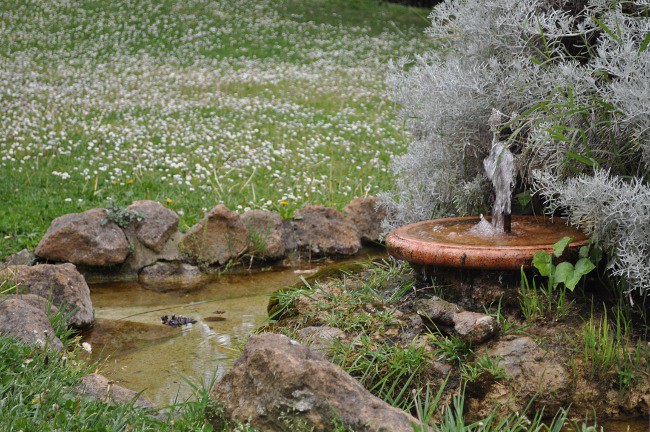

Sapienza e Solitudine (Wisdom and Solitude)





The Balcony of the Roses from outside


The Turret

The Room of the Nail from outside
INSIDE:

The Lunch Hall
This room is characterized by the fine wood panelling that covers all the walls and frames the four doors. The panels are carved into laurel branches and berries, with inserts made from light wood creating a ribbon pattern, which is outlined by squares of bronze.

Stained glass with grape bunches and leaves, Laboratorio Picchiarini 1914 c.a.

The Smoking room (stained glass with views of the park)
This light-filled room was fitted out with wicker furniture and used by the prince as a smoking room. The bow window, which looks out onto the park, was decorated with wood panelling carved with roses. The window was added to the nineteenth century construction in 1910 and contains stained glass decorated with garlands of flowers and ribbons. The glass was made by Cesare Picchiarini and involves coloured pieces of glass laid in sheets over transparent glass.

Salottino delle 24 ore (Room of the 24 hours)
The vault of the cupola, which was painted in 1909 by Giovanni Capranesi, is divided into eight panels, demarcated by stucco, which depict the 24 hours dancing among rose tendrils. The backdrop is painted with comets, which, along with roses, are the heraldic symbols of the Torlonia family. The floor is decorated with a polychrome nineteenth century mosaic, which depicts Mars and Venus and comes from the House of the Princes, and is framed with coloured marble. The walls were once covered with precious damask cloth, silver and gold in colour, but it has since been lost.


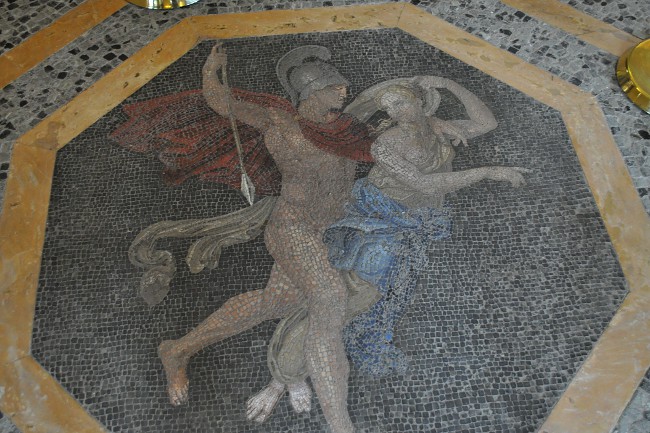

Preparatory sketches in The Room of the Clover for the stained glass of the Waldesian Church in Piazza Cavour in Rome, by Paolo Paschetto

The Room of the Owls, detail by Duilio Cambellotti 1914
This small room was originally decorated in the elaborate imperial style of wood panelling and had rich drapes hanging from the ceiling. Only a few fragments of this décor remain, insufficient for a reconstruction of the furnishings to be possible. The only original decorative element that remains is a piece of stained glass, composed of three panels by Duilio Cambellotti. The two side panels are decorated with stylized owls and the central panel with ivy and ribbons. The owls are made from coloured glass, partly painted with flame, to improve the effect of the plumage.


Staircase to the 1st floor

The Prince’s Bathroom
The beautiful majolica work, produced by Villeroy and Bosch, which once covered the walls with depictions of nymphs, had almost completely disappeared. The few pieces which remain have been made into one panel and left in place to document the bathroom’s original decoration. Today two peach-pine sideboards with enamelled glass panels are on display in the room. They are the work of Duilio Cambellotti and were acquired from his heirs.

The Prince Bedroom (detail of the Bats Chandelier)
The Prince’s bedroom has retained almost none of the original furnishings that once made it one of the places most intimately expressive of Giovanni Torlonia’s dark and misanthropic character. It was originally full of the symbolism of owls and night birds in general, including the large tondo in the centre of the ceiling, which depicts bats flying with their dark wings outstretched and has, fortunately, survived. The bow window, opening onto the park, had wooden drawers all around it, with a small desk in the centre to create an intimate corner reserved for study. A stained glass piece by Cambellotti called “The Owls at Night” once stood in an alcove in one of the walls.

Duilio Cambellotti’s work


The Balcony of the Roses
The narrow passage next to the Prince’s bedroom is articulated by a sequence of stained glass pieces designed by Paolo Paschetto and created by Cesare Picchiarini from the sketches displayed in the smoking room, with a composition of Roses, ribbons and butterflies. The lively, sunny images created a distinct contrast to the bedroom’s gloomy atmosphere.

The Staircase of the Four Season
The sequence on the walls follows the theme of the four seasons: Spring, Summer and Autumn follow one after the other. Winter, however, is missing, as the work was unfortunately lost, and the image of Spring is not the original, but a copy made by the Giuliani Glass Works in 1997, based on the sketches which have survived. The rhomboid panels of glass in the ceiling were designed by Duilio Cambellotti and have the theme of migratory birds: “Swallows”, “Skylarks”, “Thrushes” and “Migrating Birds”.
Only “Migrating Birds” is an original piece, the other three were made in 1997 by the Giuliani Glass Works, based on the sketches.

The Room of the Satyrs
This tiny and extremely richly decorated room is formed from the dome of the octagonal cupola. Its name comes from the series of miniature stucco satyrs which sit around the edge of the eye opening up into the lantern above. There is more delicate stucco work along the walls and the doors open onto a charming balcony made of carved wood, surmounted by a cupola covered with fine wood work.

The Room of the Swallows
This room was added to the building by Vincenze Fasolo in 1918-19 during the last phase of the enlargement. It originally had a ceiling painted with swallows in flight, but no trace of it now remains. However the theme of swallows is still present in the fine glass and the stucco work. In the four corners of the ceiling were four stucco reliefs depicting stages in the life cycle of the swallow: courtship, brooding, hatching and feeding.

The swallows, Laboratiorio Picchiarini 1914 ca.



The Guest’s Bathroom
The small room was entirely covered with fine majolica work, depicting cascades of bunched of yellow grapes at the high up the walls and an elegant Art Deco design in the bottom strip of the walls.

Stained glass in the loggia “Lake with Swan” Laboratiorio Picchiarini ca 1914

The Room of the Cyclam (detail of The Peacocks)
The room takes its name from the fine floor of marble agglomerate tiles decorated with cyclamen, which was designed by Umberto Botazzi and made by the Vianini firm. Displayed in this room are a number of sketches for stained glass from the Picchiarini Archive, but the most outstanding object in the room is the huge stained glass work known as “The Peacocks”, which was made by Umberto Bottazzi.


The Turret Rooms (detail of Duilio Cambellotti’s work)
These two rooms, set next to the medieval style brick tower, do not have any remarkable decoration, except for some simple stucco work of stylised ribbons.

view from the Turret

Duilio Cambellotti Work

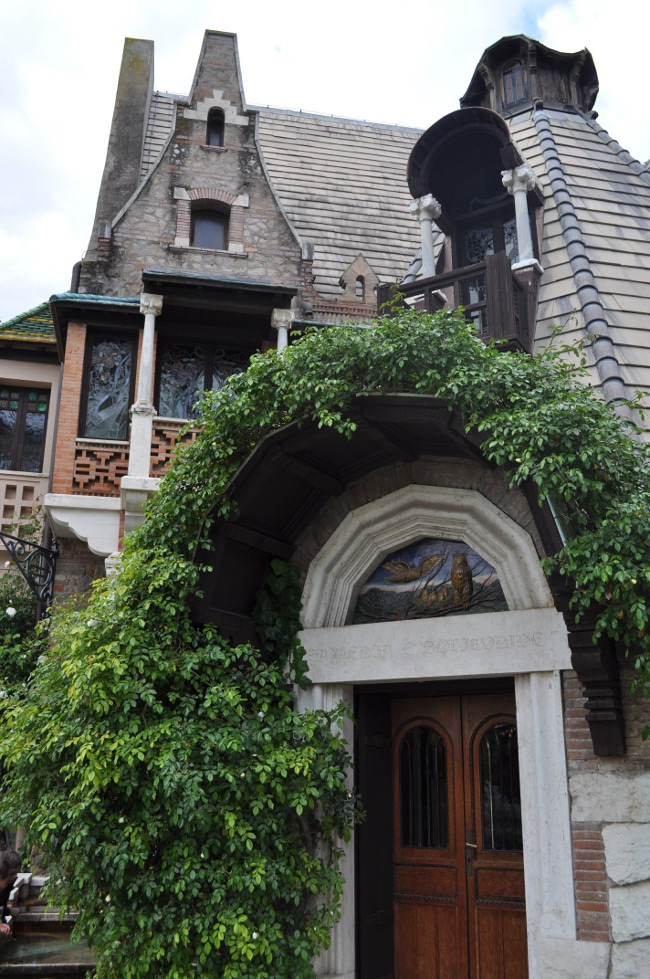
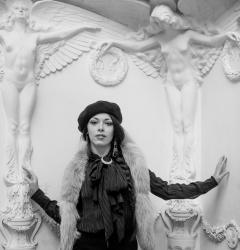


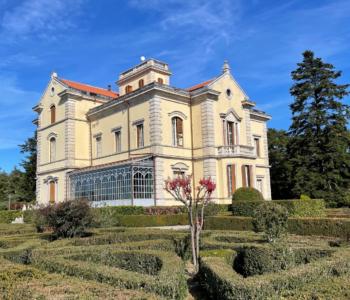
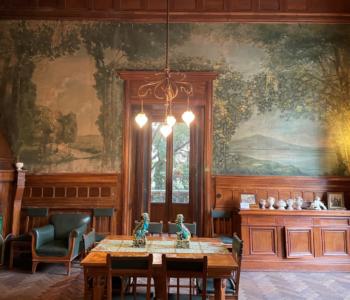
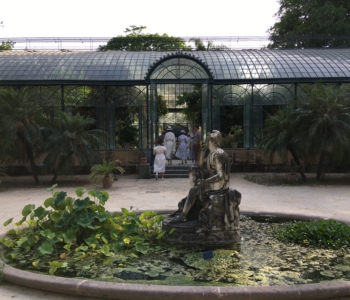
Trackbacks per le News